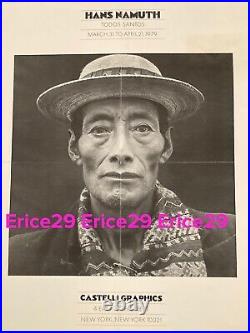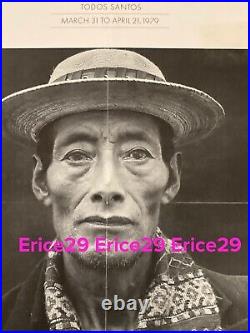Posts tagged graphics
1979 Hans Namuth Todas Santos March 31 to April 21, 1979 Exhibition Poster Leo Castelli Graphics. 4 East 77th Street. New York, New York 10021. Hans Namuth (March 17, 1915 – October 13, 1990) was a German-born photographer. Namuth specialized in portraiture, photographing many artists, including abstract expressionist Jackson Pollock. His photos of Pollock at work in his studio increased Pollock’s fame and recognition and led to a greater understanding of his work and techniques. Namuth used his outgoing personality and persistence to photograph many important artistic figures at work in their studios. Died October 13, 1990 (aged 75). East Hampton, New York, United States. Namuth photographed many other painters such as Willem de Kooning, Robert Rauschenberg, and Mark Rothko and architects such as Frank Lloyd Wright, Philip Johnson, and Louis Kahn. Namuth focused on his rapport with his subjects, getting many reclusive figures such as Clyfford Still to agree to be photographed. Namuth’s work not only captured his subjects in their studios with their works, but also captured the relationship between photographer and subject as well as the subjects’ levels of self-consciousness. Besides famous art figures, Namuth photographed the Mam people of Todos Santos, whose native lifestyles were being overrun by Western influences. Namuth died in a Long Island car crash in 1990. One of Namuth’s many photos of Jackson Pollock painting with his “drip” method. Hans Namuth was not initially interested in the work of Jackson Pollock, but was convinced by his teacher Alexey Brodovitch that Pollock was an important painter. In July 1950, Namuth approached Pollock and asked to photograph the artist working in his studio. Pollock agreed, encouraged by his wife, Lee Krasner, who was aware of the importance of media coverage. The resulting images helped to demystify Pollock’s famous “drip” technique of painting, revealing it to be a deliberative process rather than a random splashing of paint. They “helped transform Pollock from a talented, cranky loner into the first media-driven superstar of American contemporary art, the jeans-clad, chain-smoking poster boy of abstract expressionism, ” according to acclaimed culture critic Ferdinand Protzman. Not satisfied with black and white stills, Namuth wanted to create a color film that managed to focus on Pollock and his painting at the same time, partially because he found more interest in Pollock’s image than in his art. His solution was to have Pollock paint on a large sheet of glass as Namuth filmed from underneath the work. As Namuth could not afford professional lighting, the film was shot outside Pollock’s Long Island home. This documentary (co-produced with Paul Falkenberg) is considered one of the most influential for artists. In November 1950, Namuth and Pollock’s relationship came to an abrupt conclusion. After coming in from the cold-weather shoot of the glass painting, Pollock, who had been treated in the 1930s for alcoholism, poured himself a tumbler of bourbon whiskey after supposedly having been sober for two years. An argument between Namuth and Pollock ensued with each calling the other a “phony”, culminating in Pollock overturning a table of food and dinnerware in front of several guests. From then on, Pollock reverted to a more figure-oriented style of painting, leading some to say that Namuth’s sessions robbed Pollock of his rawness and made Pollock come to feel disingenuous about doing things for the camera that he had originally done spontaneously. Art critic Jonathan Jones suggests that by filming Pollock, Namuth “broke the myth of trance” and by framing Pollock’s work in the larger surrounding landscape, destroyed Pollock’s view that his paintings were boundless. Jeffrey Potter, a close friend of Pollock’s, described Namuth as commanding, frequently telling Pollock when to start and stop painting. According to Potter, Pollock felt what was happening was phony. ” Namuth himself describes Pollock as being “very nervous and very self-conscious of the filming at the time, but less so when Pollock discussed it in a later interview. During his time with Pollock, Hans Namuth had created two films and captured more than 500 photographs of the artist. These photos were first published in 1951 in Portfolio, a journal edited by Alexey Brodovitch and Franz Zachary. After the death of Pollock in 1956, Namuth’s photos grew in popularity and were often used in articles about the painter in place of Pollock’s artwork itself. Art historian Barbara Rose states that the photographs changed art by focusing on the creation of art rather than the final product alone. Younger artists such as Bruce Nauman, Richard Serra, and Robert Morris were able not only to view Pollock’s paintings, but, with Namuth’s images, to see Pollock in the act of painting, giving rise to the popularity of Process Art. These photos have also allowed art historians to dissect the details of Pollock’s method. For example, art historian Pepe Karmel found that Pollock’s painting in Namuth’s first black-and-white film began with several careful drippings forming two humanoid figures and a wolf before being covered beneath several layers of paint.





































